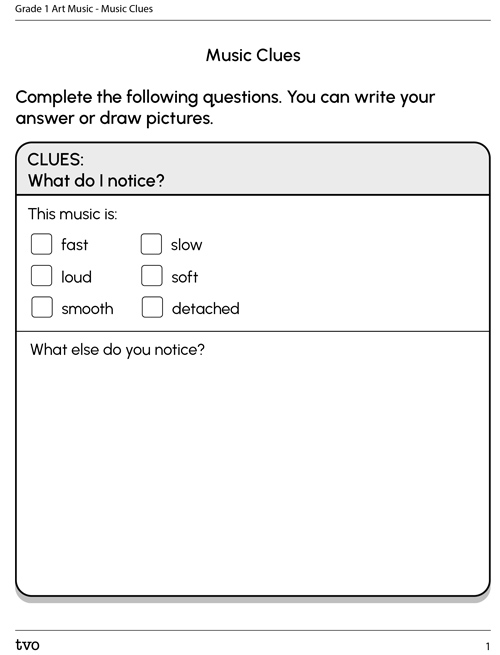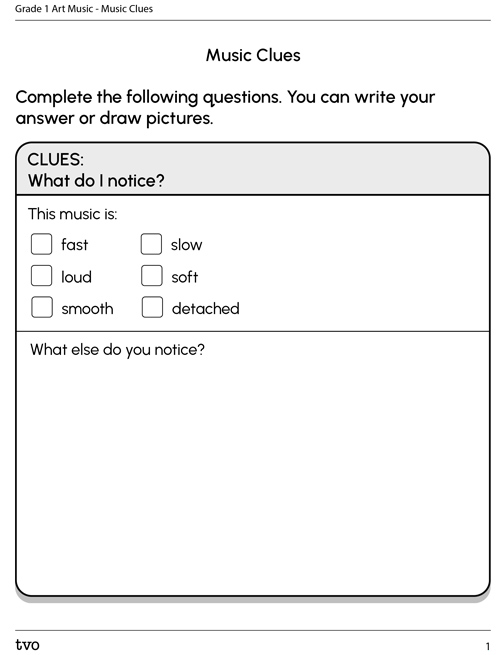Minds On
Today’s vocabulary
How fast or slow a piece of music is performed. Connected to the element of duration.
The level of softness or loudness, or intensity. Some examples include: crescendo, decrescendo; forte (f – loud), fortissimo (ff – very loud), mezzo forte (mf – moderately loud); piano (p – soft), pianissimo (pp – very soft), mezzo piano (mp – moderately soft).
Music that is played or sung smoothly, without gaps between the notes.
Music that is played or sung short and detached. Indicated by a dot above or below the note head.

Let’s get started!

We are going to explore some sounds.
As you explore, think about how someone might move to each sound.
How could you move? If possible, try it out!
Safety
Before you begin:
Ready? Let’s explore the following sounds!
Waves
Wind
Clock ticking
Water dripping
Action
Get ready, get set…
Just like the sounds around us, music can be smooth or detached.
Music can be smooth like lake waves gently lapping on the beach and a strong whistling wind.
Music can also be short and detached like a ticking clock and a dripping faucet.
Explore the following images to learn more about smooth and detached music.
“Twinkle Twinkle Little Star”
Let’s explore a lullaby called, “Twinkle Twinkle Little Star.”
Press the ‘Lullaby’ button to learn about what this word means.

This lullaby is sung in the Tlingit language.
Press the ‘Hint’ button to learn more about Tlingit.
Tlingit is not just the name of a language but also the name of the Tlingit people. Tlingit means “people of the tides.”
The Tlingit are Indigenous peoples of the Pacific Northwest regions of British Columbia, Yukon, and Alaska.

Are you ready? Let’s explore the lullaby “Twinkle Twinkle Little Star.”
“Twinkle Twinkle Little Star”
Source: Courtesy of Sealaska Heritage Institute
Question time
What do you notice about the lullaby? Answer the following questions about this song.
Investigate
Music clues
Did you know that music gives us information about what it’s used for?
Let’s use what we’ve noticed (our clues) about “Twinkle Twinkle Little Star.”
Use your clues to answer the following questions:
- How might “Twinkle Twinkle Little Star” make someone feel? (for example, excited, calm, or sleepy)
- What might someone use “Twinkle Twinkle Little Star” for?
You can record your answers on the following fillable and printable Music Clues document. You can also complete these questions in your notebook or using another method of your choice.
Complete the following questions. You can use pictures and/or words.
When you’re ready, press the ‘Answer’ button to reveal some possible answers.
|
CLUES: What do I notice? |
|
|
This music is: |
|
|
What else do you notice?
The song is sung in different language. |
|
|
CONCLUSIONS: |
|
This music might make someone feel… |
|
This music might make someone feel calm and relaxed. |
|
I think this music might be for… |
|
I think this song is for going to sleep. 
|
Go!
Now it’s your turn!
Explore the following song. It is called “Funga Alafia,” and it is sung by Nana Malaya.
As you explore the song, think about the following questions:
- What is the tempo of the music? Is the music fast or slow?

Fast

Slow
- What are the dynamics of the music? Is the music loud or soft?

Loud

Soft
- Is the music smooth or detached?

Smooth

Detached
Access the following video to explore a performance of “Funga Alafia” by Nana Malaya.
Record your thoughts about the song in the following fillable and printable Music Clues document. Answer the questions with words, pictures, or another method of your choice.
Consolidation
Putting it all together

Go back to your responses in the Action section.
Access the following video to explore a performance of “Funga Alafia” by Nana Malaya.
Use the conclusions you recorded, and the words smooth and detached to create and/or describe possible ways to move to the music.
For example, for music that is smooth, someone might create connected movements.
Access the following example of a smooth movement.
For music that is detached, someone might create short or choppy movements.
Access the following example of a detached movement.
Record your ideas about smooth and detached music using a method of your choice.
You can choose to:
- draw pictures and label the important parts using the words smooth and detached
- tell someone using the words smooth and detached
- write about it using the words smooth and detached
- make a recording using the words smooth and detached
Reflection
How do you feel about what you have learned in this activity? Which of the next four sentences best matches how you are feeling about your learning? Press the button that is beside this sentence.
I feel…
Now, record your ideas about your feelings using a voice recorder, speech-to-text, or writing tool.









